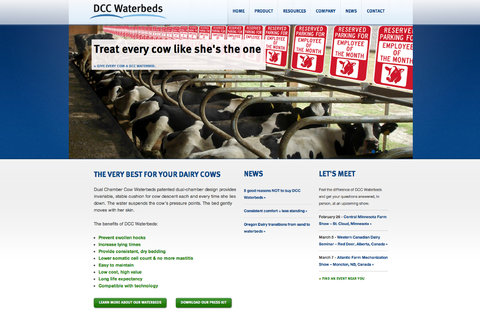
On Social Media
Generating revenue along with the buzz.
Stop. Don’t send that tweet. Don’t post that video on YouTube. It’s time to face facts: It doesn’t make sense to do anything in social media if you don’t have a good Web site.
Your Web site is your welcome mat. It’s your most important selling tool. The ultimate goal of social media marketing is to drive traffic and potential customers to your Web site and then convert those leads into phone calls, meetings and sales. And yet, if you are great at social media but have a lousy Web site, your social media efforts will just allow you to annoy more people faster.
If your Web site needs work, do not put it off. But be careful about who you hire to build, update and maintain your site. The process is time consuming and full of lots of opportunities to learn expensive lessons. There are plenty of snake-oil salesmen and brothers-in-law (and even brothers) who prey on those who are not technologically savvy. Over my next few posts, I’m going to discuss the process of hiring a Web developer to build a site, and I’ll also offer some alternatives to a full overhaul.
In 2012, after surviving for nearly 12 years in business with a one-page Web site, Advanced Comfort Technology finally decided to invest in a Web site for its main product, DCC Waterbeds. Based in Reedsburg, Wis., the family business builds waterbeds for dairy cows and takes in about $4 million a year in revenue. Yes, cows sleep on waterbeds. (Apparently lying on a waterbed protects the cows who lie down an average of 14 hours a day.)
Amy Throndsen, 32, daughter of the founder, joined the company in 2011 and embarked on a mission to brand the company’s product and introduce a real Web site. While living in Washington, Ms. Throndsen had made friends with the owner of a business that built Web sites. Once she started working on the DCC Waterbeds project, she reached out to her friend’s company. “I trusted them, but I was naive and didn’t know what I needed to know to go in informed,” Ms. Throndsen said. “Developers use this technical jargon — S.E.O., optimization, registered wireframes, coding — as scare tactics. And I bought it.”
The company proposed building the site for $25,000. While $5,000 was billed for logo development and branding, the rest of the budget was for development and search engine optimization services. The first invoice prompted no concerns and was paid without hesitation. But then the second itemized invoice came in, and the team got suspicious. “When I saw that they wanted to charge us $1,000 for consulting and strategy on Google Alerts, something we had done in 10 minutes, I started to question every other line item in the proposal,” said Holly Harper, Advanced Comfort’s communication director.
The invoice included a $4,000 charge for Web requirements and analysis and additional charges for Facebook contest research and strategy, review of existing company videos of waterbeds, geolocation-mapping of product users, and competitive research analysis of content marketing efforts. Ms. Harper found these charges odd, in part because the geolocation mapping was handled by a free app, and Advanced Comfort had written the content-marketing copy itself. On top of the $25,000 initial proposal, the Web developer wanted a monthly $1,000 maintenance fee.
When Ms. Throndsen asked for an explanation, she said she was told, “You just don’t understand the back-end work we are doing.”
“Well, help me understand,” she said she responded. She said she was then told that she should send an e-mail with her specific questions. Eventually, her developer just stopped answering her phone calls and text messages. “We paid the second invoice, and terminated the contract,” Ms. Throndsen said. And she got the files for the logo, the home page, and the wireframes for nearly $15,000.
When asked if $25,000 fee seemed high initially, Ms. Throndsen said, “Yes, it did, but I trusted my friend who had built a Web site with him, and I decided to move forward.”
After firing the developer, Advanced Comfort Technology ended up paying $2,100 to a sole practitioner who used the logo, photos and copy to build a basic WordPress site that the company is still using. Another sole practitioner maintains the site on an as-needed basis for roughly $1,000 a quarter. “Our Web site is not perfect in the back end,” Ms. Harper said, “but we are No. 1 in Google search for all things related to cows and waterbeds and a number of other search terms — thanks to our blog on our Web site.”
Having survived the experience, here are Ms. Throndsen’s tips:
• Do your homework. Talk to other small-business owners about who they used and what the process was like. Don’t let your vendor confuse you with jargon.
• Get multiple quotes. We went to a company we thought we could trust — they were personal friends, so we thought a professional
relationship would be seamless. We were naive.
• Get references: Talk to the vendor’s customers. You want to make sure the company is willing to be transparent about what it does and how it does it.
“We did none of this,” Ms. Throndsen said, “and we have a site that hobbles along — like a house with a beautiful fresh coat of paint and walls full of termites.”
Melinda Emerson is founder and chief executive of Quintessence Multimedia, a social media strategy and content development company. You can follow her on Twitter.
Article source: http://boss.blogs.nytimes.com/2013/05/10/the-problem-social-media-cannot-solve/?partner=rss&emc=rss
Speak Your Mind
You must be logged in to post a comment.